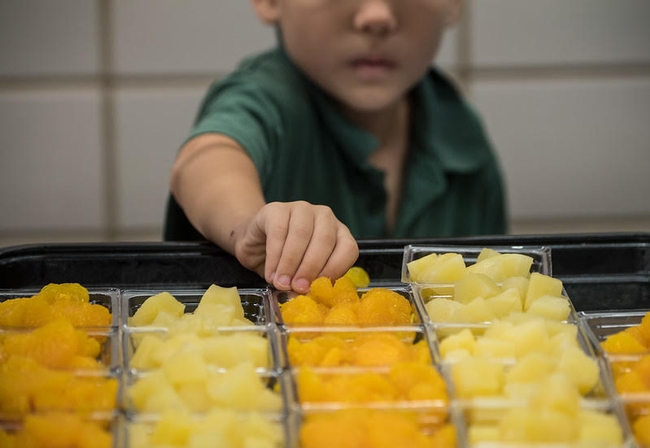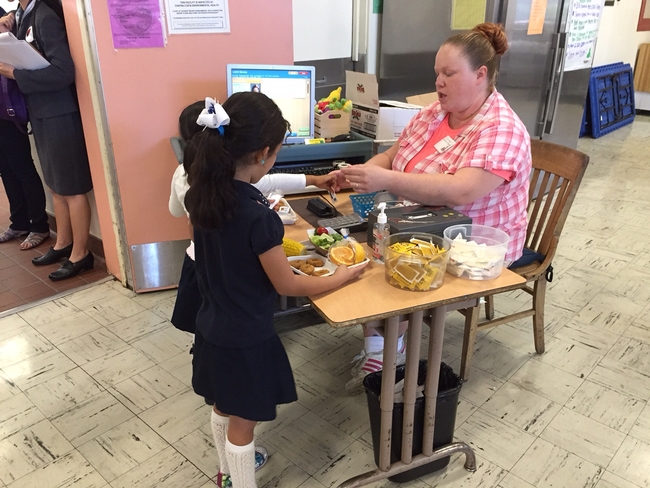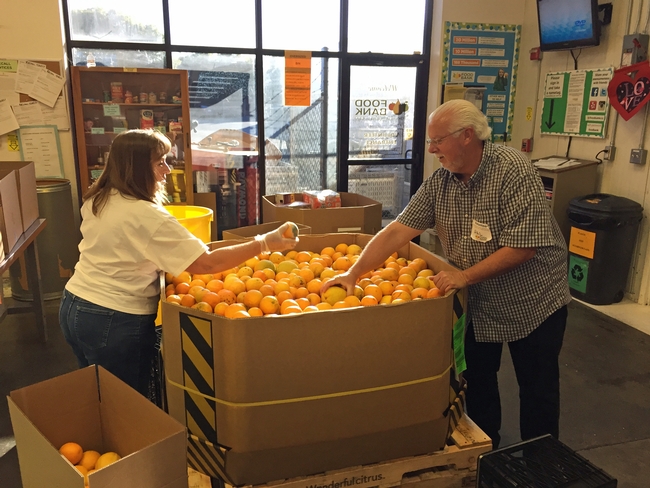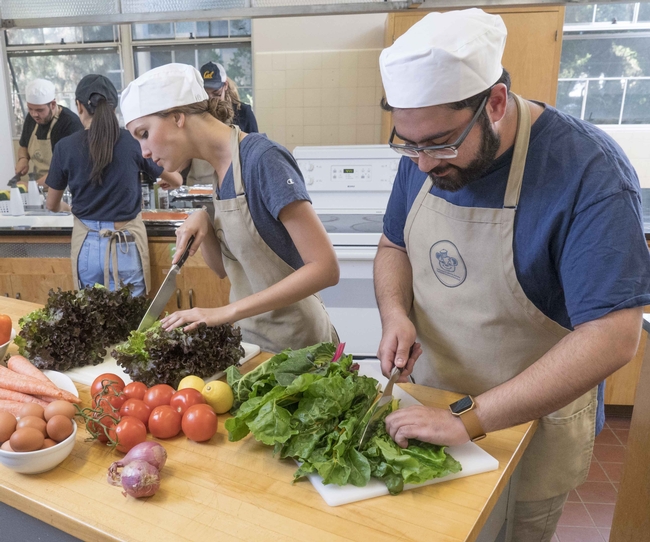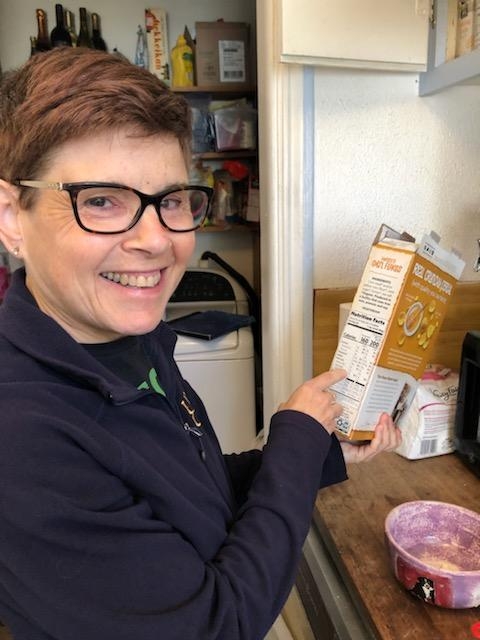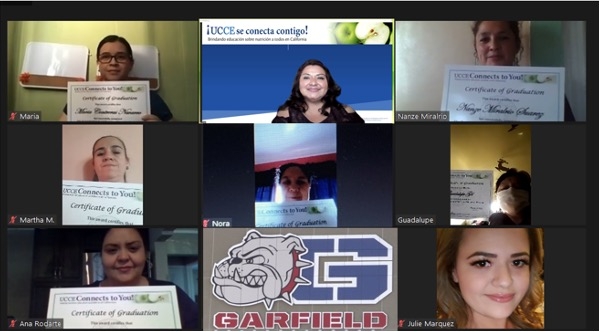Posts Tagged: nutrition
Universal school meals increased student participation, lessened stigma
The COVID-19 pandemic exacerbated food and nutrition challenges. Many families initially lost access to meals offered by school and childcare facilities, experienced unemployment or work reductions, and faced increasing prices for food and other necessities. National and state policies and programs provided food and cash assistance to mitigate impacts on food security. Researchers at the Nutrition Policy Institute, a research center of University of California Agriculture and Natural Resources, evaluated safety-net policies implemented during the pandemic to better support families with low incomes in the U.S.
Benefits of universal school meals
The National School Lunch Program and the School Breakfast Program meet the nutritional needs of approximately 30 million K-12 students in America each day. Typically, students from families meeting income eligibility criteria receive school meals for free or a reduced price, while others pay full price.
NPI researchers Wendi Gosliner, project scientist, and Lorrene Ritchie, director and UC Cooperative Extension specialist, are co-leading studies of school meals in California in collaboration with researchers from the NOURISH Lab for Health Inclusion Research and Practice, who study school meals in Maine and other states.
During the COVID-19 pandemic, Congress funded school meals for all students at no charge, in order to address the dramatic increase in food insecurity among families with children after schools shut down in March 2020. This federal provision allowing for meals to be free for all students ended after the 2021-2022 school year, but some states elected to continue providing universal school meals with state funding, in recognition of the importance of these meals for student health and academic success.
California was the first state to adopt a statewide Universal Meals Program starting in the 2022-23 school year. To support the program's development, $650 million were invested to help schools improve kitchen infrastructure and provide staff training and technical assistance. Investments include Farm to School programs and other mechanisms to help update and improve school meals. Maine and several other states also have adopted universal school meals at least through the 2022-23 school year.
“States often act as incubators – things that work well in states sometimes get translated into federal policy,” Gosliner said. Identifying the success of the programs – and their challenges – can lead to improvements and help inform advocates and policymakers considering universal school meals policies at the state and national level.
Two of the team's research studies in California and Maine documented the benefits and challenges of universal school meals, as reported by school food authorities. Among 581 school food-service leaders in California who responded to the survey, nearly half (45.7%) reported reductions in student stigma as a result of providing free school meals to all students. Among 43 respondents in Maine, over half (51%) reported lessened stigma related to school meals being free for all. In both studies, nearly three-quarters of respondents reported increases in student meal participation. These and other data suggest that universal school meals are meeting their aim, to increase student participation while providing nutritionally balanced meals.
But when the child leaves campus, the responsibility to put a nutritious meal on the table falls on the caregiver.
“Universal school meals provide food and can ease families' budgets, but for too many families, wages as well as time and other resources are not adequate for access to and consumption of enough healthy foods and beverages,” Gosliner noted.
That is when other public programs are helpful, for example the Earned Income Tax Credit, or EITC.
Many eligible families do not claim Earned Income Tax Credit
The Earned Income Tax Credit is a national program designed to lift families out of poverty. The supplemental income can contribute up to nearly $7,000 per year for a family. Despite the EITC's known ability to improve participants' health, research shows that many EITC-eligible households in California and across the nation don't receive the benefits for which they are eligible, leaving $2 billion unclaimed in California in 2018 alone.
Gosliner led a study along with Lia Fernald from UC Berkeley and Rita Hamad from UC San Francisco to document levels of awareness, barriers to uptake, and benefits of participation in the EITC. Their recent publication reported that among 411 EITC-eligible California female caregivers, those who were younger, spoke languages other than English, and had less awareness of the EITC were less likely to receive the tax credit.
Developing a user-friendly system for providing safety-net support and, in the meantime, providing information and support to help more EITC-eligible families receive these benefits are suggested to help alleviate financial stressors. In the long term, these strategies may reduce poverty and improve the health of children.
Increasing WIC Cash Value Benefit a boon to health
In addition to universal school meals and EITC, families with low income may be eligible for the Special Supplemental Nutrition Assistance Program for Women, Infants and Children, or WIC. The program supports women and children up to 5 years old through nutrition education, nutritious foods and access to other health and social services.
One component of the WIC food packages, the Cash Value Benefit, provides participants a fixed dollar amount to supplement their family's diet with fruits and vegetables. During the pandemic, the U.S. Department of Agriculture increased this benefit from $9 to $35 per month, which was later revised to $24 per month per child in October 2021.
Ritchie contributed to a growing body of evidence on the importance and multidimensional benefits of the WIC Cash Value Benefit increase.
“Nine dollars buys only a quarter of what a child is recommended to eat every day,” Ritchie said. “The increase in Cash Value Benefit during the pandemic was an ideal natural experiment to investigate its impact.”
In collaboration with Shannon Whaley and her team at the Public Health Foundation Enterprises-WIC, NPI launched a longitudinal cohort study of nearly 2,000 California WIC participants. They found that the increased Cash Value Benefit improved WIC participant satisfaction with the program and allowed families to purchase greater quantities and varieties of fruits and vegetables.
“The increased Cash Value Benefit enabled WIC families to expose young children to new fruits and vegetables. Early exposure to a variety of fruits and vegetables is critical to establishing lifelong healthy habits,” said Ritchie.
The researchers found that the benefit increase also reduced food insecurity. It is hoped that the increase in program satisfaction translates into more eligible families enrolling and continuing to receive WIC. In November 2022, the U.S. Department of Agriculture proposed making the increased Cash Value Benefit a permanent part of WIC.
Knowing the proven benefits of the WIC program, Ritchie and colleagues from the National WIC Association, and Loan Kim at Pepperdine University, also engaged with WIC participants in other states.
In 2021, all state WIC agencies were invited to participate in a WIC satisfaction survey. Of the 12 WIC state agencies that opted to participate, Connecticut, Inter Tribal Council of Arizona, Nevada, New Hampshire and New Mexico added questions on the survey to understand how the increased Cash Value Benefit impacted children's dietary intake.
The study showed consumption of fruits and vegetables by children on WIC increased by one-third cup per day on average, which is sizable when considering the impact across the WIC population.
NPI research on universal school meals, the EITC and WIC constitute a small part of a more comprehensive approach to make healthy food more accessible, affordable, equitable and sustainable for all. The NPI provides resources such as policy briefs, peer-reviewed publications and technical assistance on several research areas such as safe drinking water, childcare and education. To learn more, please visit the Nutrition Policy Institute website.
Can food banks better promote nutrition and health?
New tool helps assess policies and practices
An estimated 53 million people in the U.S. turned to food banks and community programs for help putting food on the table in 2021. In recent decades, food banks have adopted policies and practices to make sure people not only have access to food but also healthy and nutritious food.
But until now, food banks have had few ways to evaluate those initiatives.
University of California, Davis, Assistant Professor of Cooperative Extension Cassandra Nguyen led a team of researchers to develop the Food Bank Health and Nutrition Assessment to address that concern. Their findings were published in the journal Public Health Nutrition.
“This tool will allow food banks to reflect on their current practices and determine whether they can adopt additional strategies to promote nutrition and health. It also serves as a benchmark, which they can use to track their progress over time,” said Nguyen, with the UC Davis Department of Nutrition.
Nutrition policy is more than what's on the shelf
Food banks face some common challenges in promoting nutrition, health and equity. While food banks could assess the nutritional quality of their inventory, Nguyen said promoting nutrition requires more than knowing the types of food on the shelf.
“Food banks can have nutrition policies that outline where they source food and which foods they prioritize when funding is available. They can also ensure that food pantry clients are either represented on advisory boards or are able to provide feedback about foods they would like to receive,” Nguyen said.
Additionally, food banks can take steps to make sure nutrition education materials and information about federal assistance programs for health and nutrition are available in languages spoken by recipients.
Partnerships with outside organizations and local farmers can also increase the variety and availability of nutritious foods. Food banks with diverse connections may also adapt better to unexpected spikes in need, such as during the COVID-19 pandemic.
The Food Bank Health and Nutrition Assessment was designed to evaluate these and additional objectives so food banks can identify areas of success as well as potential strategies they hadn't considered before.
Importance of data
“By having data from this assessment to show that some practices to promote nutrition and health may be difficult to implement, several food banks can raise their voices to advocate for policy changes,” Nguyen said.
Food banks with Feeding America and the Midwest Food Bank in four Midwestern states participated in the initial development of the Food Bank Health and Nutrition Assessment. In this small initial sample, most food banks asked food recipients about their preferences or whether diet-related diseases (for example, diabetes) were common, but few had current or former charitable food recipients on advisory boards.
The assessment is available for free through Feeding America, the largest nonprofit organization supporting the charitable food system, and online through the University of Illinois Extension. Food bank staff and partnering community-based professionals such as extension staff can use the assessment to improve promotion of nutrition and health.
Other authors include Caitlin Kownacki, Veronica Skaradzinski, Kaitlyn Streitmatter, Stephanie Acevedo and Jennifer McCaffrey with the University of Illinois at Urbana-Champaign; Stephen D. Ericson with Feeding Illinois; and Jessica E. Hager with Feeding America.
Funding for the research was supported by the Supplemental Nutrition Assistance Program-Education, or SNAP-Ed, in Illinois
Teaching Kitchen course helps improve college students’ food security
Cooperative Extension researcher: Nutrition course a boon for UC Berkeley students
College students across the nation are struggling to meet their basic food needs. Within the University of California system of 280,000 students, 38% of undergraduate students and 20% of graduate students report food insecurity.
As part of the UC Global Food Initiative, in 2015 the Nutrition Policy Institute (a UC Agriculture and Natural Resources statewide research center) identified student food insecurity as a UC systemwide problem, prompting the UC Regents and campuses to collectively address the issue.
All 10 UC campuses now have on-site basic needs centers, providing food, emergency housing and support services. The UC system and campus working groups recognize that meeting basic needs, such as food, is a multidimensional challenge.
In response to the 2022 White House Conference on Hunger, Nutrition, and Health, which called for national efforts to reduce diet-related disease and food insecurity, UC renewed their commitment to cut the proportion of students facing food insecurity in half by 2030. Campuses will partner with local counties to maximize enrollment in the Supplemental Nutrition Assistance Program (also known as CalFresh in California), provide food for students who do not qualify for CalFresh, and allocate campus food resources to historically underserved student populations.
NPI's collaborative researchers continue to monitor the impact of these efforts, in addition to other interventions, such as supporting students in building basic culinary skills, to improve food security. One multipronged approach to address food insecurity at UC Berkeley is a 14-week course on Personal Food Security and Wellness with a Teaching Kitchen laboratory component.
Sarah Minkow, who teaches the Personal Food Security and Wellness course at UC Berkeley, shared that students learn about nutrition and gain culinary skills through the Cal Teaching Kitchen.
The curriculum is designed with consideration for the time, cost and convenience of healthy eating. Discussions include food safety, calculating nutrient needs, mindful eating and reading nutrition labels. The Teaching Kitchen laboratory brings the lessons to life through knife skills, “no-cook” cooking, microwave cooking and sheet pan meals.
Minkow enthusiastically highlighted her students' “overwhelmingly positive [response to the] lecture and lab,” suggesting the benefits of an interactive learning environment to garner student engagement.
“Students often give feedback that they wish this was a required course for all UC Berkeley students,” said Minkow. She noted one barrier to reaching more students: capacity of the Teaching Kitchen space.
Susana Matias, a Cooperative Extension specialist at the UC Berkeley Department of Nutritional Sciences and Toxicology and collaborative researcher with the NPI, evaluated the impact of the Personal Food Security and Wellness course at UC Berkeley.
Matias reported that increasing food literacy and culinary skills among students has shown to increase intake of fruits and vegetables, and frequency of cooking, and reduce the number of skipped meals. Her study on the impact of the 14-week nutrition course also found a significant decrease in student food insecurity.
Across the UC System, students are benefiting from their campus Teaching Kitchens, including UC Berkeley, UC Davis, UCLA and UC Riverside. Other campuses such as UC San Diego, UC San Francisco, UC Santa Cruz and UC Santa Barbara offer basic student cooking classes as well.
Katherine Lanca, UC Global Food Initiative fellow working with NPI, attended the 2022 Teaching Kitchen Research Conference as part of her fellowship to learn about the latest research on teaching kitchens supporting equitable health outcomes.
The conference was hosted at UCLA by Harvard T.H. Chan School of Public Health Department of Nutrition in association with the Teaching Kitchen Collaborative. Teaching kitchens are a promising approach to supporting food security and cultivating lifelong habits, especially among a college student population.
Families stretch food dollars with tips from UCCE nutrition educators
Consumers save over $41 a month after attending UC Cooperative Extension nutrition workshops
Consumers have seen their grocery bills rising over the last few months. To save money, buying store or generic brands and preparing meals at home are a couple of ways to adapt in the short term, according to UC Cooperative Extension nutrition educators.
UCCE nutrition educators offer tips and workshops to help families participating in the Expanded Food and Nutrition Education Program and CalFresh Healthy Living, UC program. With the information, the families are better able to make their food dollars last all month.
“After attending the workshop series, households across California were finding a savings of over $41 a month,” said Natalie Price, UCCE nutrition, family and consumer sciences advisor in Los Angeles County.
Through a series of workshops and informational fliers, participating households have had success in reducing their food bill, improving healthy food knowledge, and improving food safety.
Currently UCCE offers EFNEP and CalFresh Healthy Living, UC lessons in 40 out of the 58 California counties. From Del Norte to San Diego County, nutrition educators are working with families to improve their diet quality and physical activity through a series of workshops available to eligible households. In a series of six to nine one-hour classes, families learn how to buy, store and prepare healthy, safe and nutritious food.
The EFNEP classes held throughout the state reach, on average, more than 17,000 participants, including attendees and household members of attendees. After taking the class, one participant said, “Before I only bought what was on sale, but now I have a shopping list. I have a menu of the week and I always look at the ingredients.”
Science-based nutrition information consistently ranks as one of the top areas of interest among the public, and these programs represent one of the premier opportunities to reach Californians with relevant resources.
“Over 90% of our program graduates reported (in post-class surveys) improved food resource management skills such as planning meals, making a shopping list, and comparing food prices, which has resulted in $19 to $64 grocery bill savings per month,” said Marisa Neelon, UCCE nutrition, family and consumer sciences advisor for Alameda and Contra Costa counties.
Knowing what to buy, how to prepare and what to eat are key to help households improve both costs and nutrition. As one participant commented, “[I make] a list before I go shopping and planning what I will cook to avoid overspending.” Knowing what to buy, how to prepare and what to eat are key to help households improve both costs and nutrition.
This success has been replicated in other counties and translated into major savings for families at the grocery store. These savings can add up and make a significant impact, especially in the current environment of rising food prices.
The UCCE nutrition educators shared their top tips to save money on food:
- Check the grocery flyers for the food sales
- Make weekly menus of the food needed for your family meals and snacks
- Buy store or generic brands instead of national brands
- Read food labels to choose items that are nutrient rich
- Purchase canned and frozen foods along with fresh items
Check the CalFresh Healthy Living, UC or EFNEP webpages for nutrition education programs offered for eligible Californians in counties across the state.
UC Agriculture and Natural Resources has a list of online resources for anyone interested in becoming more active and eating healthier at https://ucanr.edu/sites/resourcedirectory.
Should there be more microbes on your plate?
Scientists make the first large-scale estimate of live microorganisms consumed in the U.S. diet
Our diets provide us with the building blocks we need to stay healthy and fight disease. The nutrients in foods and beverages can be tallied up to know if we are getting what our bodies need. Yet what if a nutrient has been overlooked? For instance, friendly microbes in raw and fermented foods have not been measured as part of our diets — until now.
“Ultimately we want to understand if there should be a recommended daily intake of these microbes to keep us healthy, either through the foods or from probiotic supplements,” said Maria Marco, a professor in the food science and technology department at UC Davis. “In order to do that, we need to first quantify the number of live microorganisms we consume today in our diets.”
Marco co-authored a new study with a group of scientists that examined the number of living microbes per gram of more than 9,000 different foods consumed by nearly 75,000 adults and children. It found that around 20% of children and 26% of adults consumed foods with high levels of live microorganisms in their diet. Both children and adults increased their consumption of these foods over the 18-year study period. The study, published in the Journal of Nutrition, is the first large-scale estimate of how many live microbes are consumed by Americans every day.
“This trend is going in the right direction. Exposure to friendly microorganisms in our foods can be good for promoting a healthy immune system.” said Marco.
Foods for gut health
Study authors examined the National Health and Nutrition Examination Survey to create the estimate. The health and dietary database contains extensive information on the foods consumed by Americans daily. Food science and fermentation experts assigned each food an estimated range of live microbes per gram, creating categories of foods with low, medium and high levels of live microbes. Foods in the high category included fermented dairy foods such as yogurt, fermented pickles and kimchi. Fresh, uncooked fruits and vegetables were also good sources of live microorganisms, represented in the medium category.
The analysis was funded by a grant from the International Scientific Association for Probiotics and Prebiotics, or ISAPP. The microorganisms quantified in this study are not necessarily probiotics.
“By definition, a probiotic must be well-defined and have a demonstrated health benefit at a quantified dose. Live microbes associated with food as a category, however, do not generally meet the criteria of a probiotic,” said corresponding author Mary Ellen Sanders, executive science officer for the ISAPP.
The publication is part of a larger global effort to determine how live dietary microbes might contribute to health.
“There is no doubt that the microbes we eat affect our health. When we think of microbes in our food, we often think of either foodborne pathogens that cause disease or probiotics that provide a documented health benefit,” said co-author Colin Hill, a professor of microbial food safety with University College Cork, Ireland. “But it's important to also explore dietary microbes that we consume in fermented and uncooked foods. It is very timely to estimate the daily intake of microbes by individuals in modern society as a first step towards a scientific evaluation of the importance of dietary microbes in human health and well-being.”
Other scientists co-authoring the paper were ISAPP board members Robert Hutkins, Dan Merenstein, Daniel J. Tancredi, Christopher J. Cifelli, Jaime Gahche, Joanne L. Slavin and Victor L. Fulgoni III.
Editor's note: Maria Marco is affiliated with UC Agriculture and Natural Resources as an Agricultural Experiment Station faculty member.


